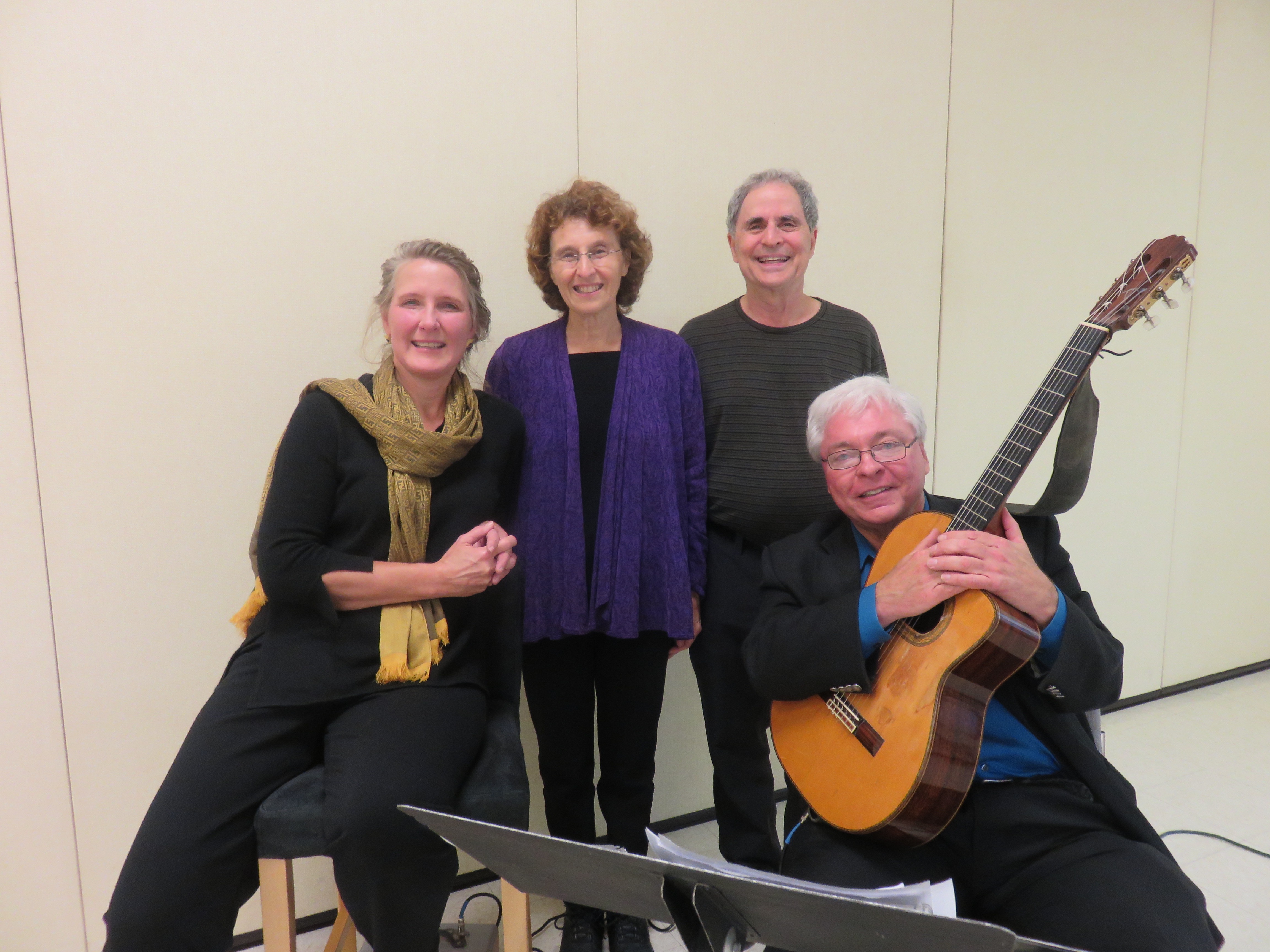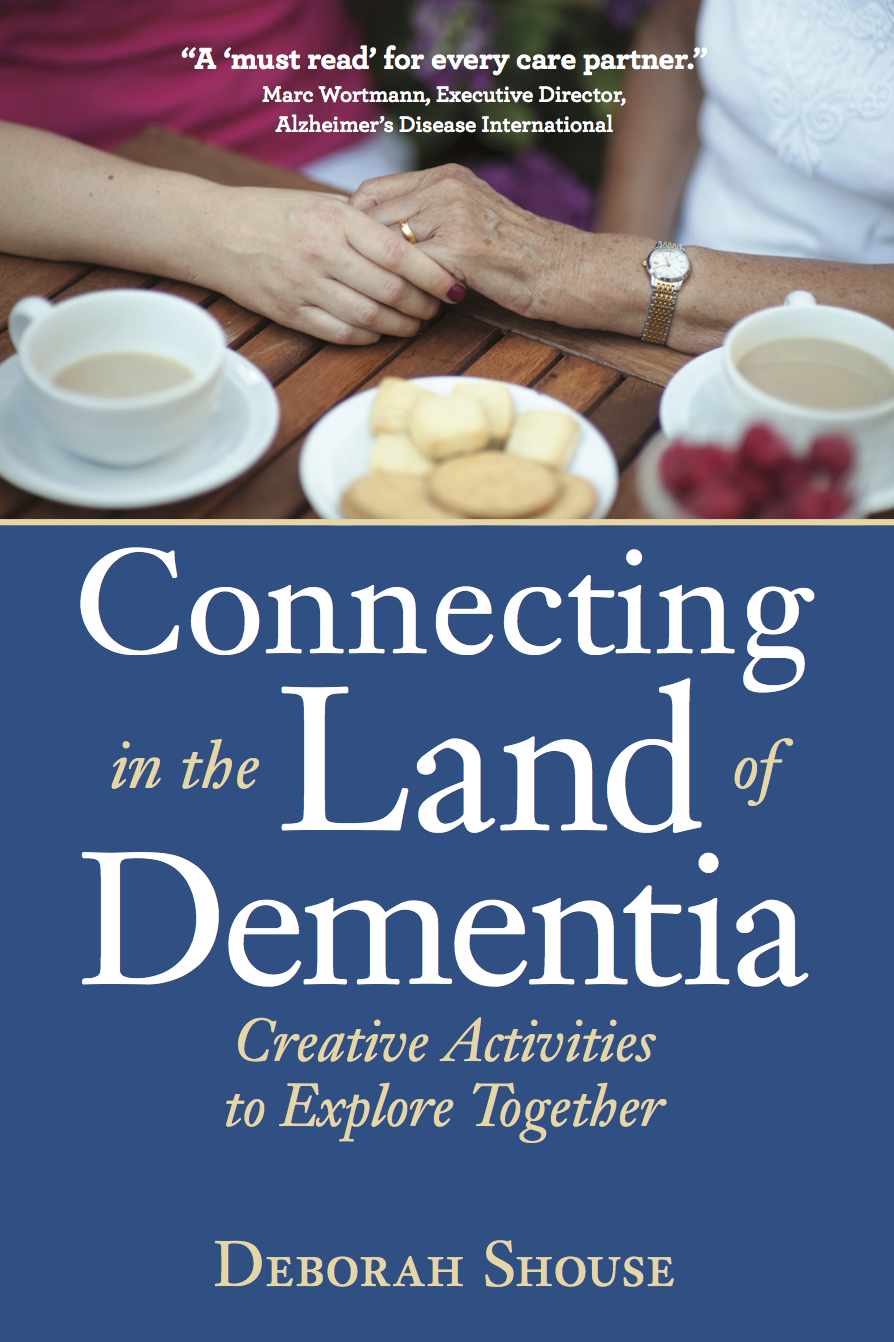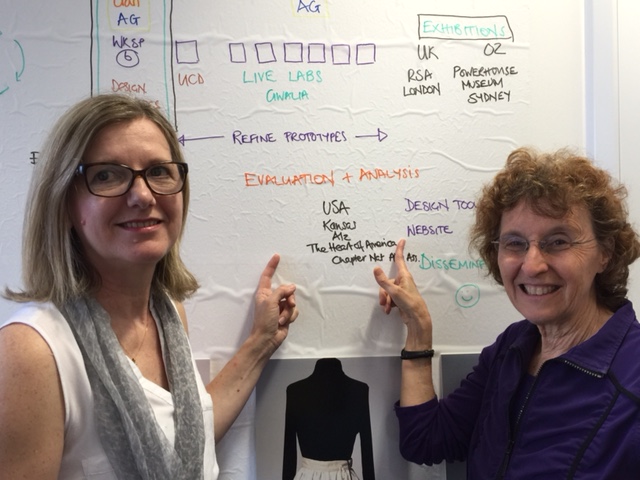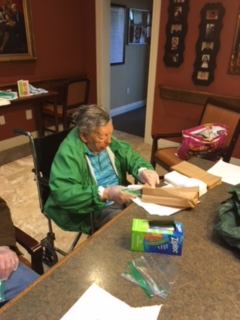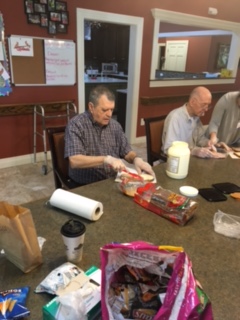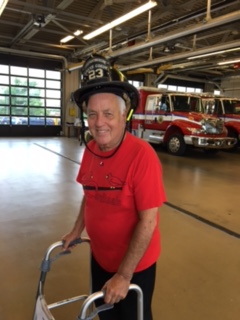Posts Tagged ‘creativity’
At Long Last: A Page-Turning Love Story
My hands trembled as I reached out my arms. For three long years I’d been working toward this meeting and yearning for this moment. Now, it was finally here. She was more beautiful than I had imagined, with a pleasing weight, just right for holding, just right for spending long hours with. From a glance, her personality seemed strong and purposeful and yet her warm, colorful exterior told me she would be easy to read. As she gradually opened up to me, I felt her power, her accessibility, her willingness to share ideas and wisdom. She felt great; she looked great; and she was brimming with exciting new ideas. Three long years and finally, she was in my arms. I hugged her tightly. At last I was holding my new book, Connecting in the Land of Dementia: Creative Activities to Explore Together
What makes this book unique? It’s the amazing people who contributed to it. During the writing process, I interviewed dozens of innovators across the globe, gathering ideas that engage the creative spirit so you can continue to experience meaningful moments throughout the dementia journey. These luminaries inspired me every step of the way and I am eager to share their ideas with you.
This book is brimming with easy projects using music, art, movies, cooking, gardening, and more. Here are some of the benefits you can look forward to when you do these activities together: Increased energy and socialization, an improved sense of purpose, reduced anxiety, and chances to express yourselves in new and meaningful ways.
Here’s even more good news about the ideas in this book. They’re adaptable for all ages and abilities, and you don’t need to have any special talents. Simply incorporate them into your daily routine and you’ll enrich your time together.
Marc Wortmann, Executive Director, Alzheimer’s Disease International, called the book “A ‘must read’ for every care partner because it really helps you to look at things differently!”
If you’re in the Kansas City area, please join us for the book launch on Sunday afternoon, October 9th, at 1:30 for a reception in the Truman Forum at the Plaza Library. The free presentation will begin at 2:00 This lively program, filled with ideas, stories, and songs, features myself and my partner Ron Zoglin, musical luminaries Rod Fleeman and Cynthia Schroer, and guest speaker Michelle Niedens from the Heart of America Chapter, Alzheimer’s Association.
RSVP 816-701-3407
For those of you in the Washington DC area, please join us at the free Alzheimer’s Foundation of America Caregiver’s Conference on Thursday September 29. We’ll be presenting there, along with other experts in the field. Click here to register.
We recently heard from several readers, saying, “This book is going to help so many people. I’m recommending it to my friends and colleagues.”
That’s what this is all about: enriching people’s lives through meaningful engagement.
It’s a challenge, bringing a new book into the world and we welcome your ideas and help in spreading the word about the book and the event.
You can order a copy now from Rainy Day Books, our book-seller for the event, or online.
Here is some advanced praise:
“A thoughtful and positive guide to the very thing I find myself constantly advocating to doctors, caregivers, and family members—social stimulation and creative arts will limit the need for psychiatric medication and improve the quality of life for those with dementia more than anything else.” Doug Wornell, MD, Life Solutions Group for Geriatric and Neurological Psychiatry
“Buy this book, read it, highlight what inspires you. As you make notes and bend pages to personalize this guide, you are creating a family treasure.” Carol Bradley Burdock, Founder of Minding Our Elders
“Deborah Shouse provides a great public service by shining light on the numerous creative activities that can meaningfully engage the minds and spirits of persons living with dementia. From personalized music to storytelling, Shouse makes it easy for caregivers to understand the various options they have to help their loved ones navigate through their everyday lives.” Dan Cohen, MSW Founding Executive Director, MUSIC & MEMORYsm
Three Benefits of Artistic Alchemy
Last week, I wrote about Julian West and his work with music and dementia. Hannah Zeilig, PhD, is an expert in culture, language, and dementia, who participated in and documented Julian’s program. When I interviewed Hannah, I was inspired by her perspective on arts and communications and wanted to share a few of her key ideas.
“The project showed us that you can converse in so many ways,” says Hannah. “The musicians and the dancer reminded us that we all can communicate without language.”
“One of the questions we’re asking in the UK is ‘How can the arts help with dementia? What can arts do that a game of dominoes cannot?’ ” Hannah says. “The arts help people become brave in how they connect with each other.”
The arts also transcend our dependence on achievement, identity, and memory.
“Being scared of dementia is the biggest barrier,” Hannah says. “In our language and our media, dementia is stigmatized and portrayed as catastrophic. One of the natural and common fears is summarized by this: ‘If I can’t remember where I live and my achievements, how do I know who I am?’
Julian’s work reminds us that we are all creative.
“People with dementia can be brimming with creativity and humor and able to make connections with each other,” Hannah says.
During one of Julian’s sessions, the musicians were playing and the dancer was cavorting around the circle. One resident, Alicia, walked right up, took the dancer’s hands and lead her in a waltz.
At the end of the dance, Alicia was glowing. She smiled and said, “We really just did something.”
And she was right.
….
Other gifts from this work in the arts:
- The residents communicated with more sounds and gestures.
- The staff saw the creative side of the residents.
- The creative atmosphere opened everyone up to alternate ways to connecting.
For more about Hannah and her work, visit:
Orchestrating a Musical Conversation
When Ron’s dad was living in a memory care unit, Ron and I talked with the residents and their families, learning about their favorite songs. We orchestrated a sing-along and had fun working with everyone and putting together a scrapbook of each resident’s special tunes. The combination of music and conversation created a sense of community for us all. Julian West, who we met on a recent trip to London, is creating community through engaging people in music and dance. We really love the way he weaves the two art forms together and wanted to share his easy and adaptable ideas with you.
Julian West had no idea what would happen at the care facility, but he trusted it would be something wonderful. An accomplished oboist and a teacher at the Royal Academy of Music, Julian assembled a violist, a composer, a dancer, and an artist to share energy and their art with people who are living with dementia.
“This was an experiment to see what could happen,” Julian says. “We worked completely improvisationally.”
Once a week, for eight weeks, the troupe came to the residential care home and created a living arts experience with residents and staff. They began by inviting everyone to choose a percussion instrument, such as rain sticks, bells, shakers, tambourine, etc.
“We had a musical conversation,” Julian says. “One person made a sound and another answered. We also chatted a lot. People commented on the music or expressed an emotion or impression.”
The musicians added their instruments and the staff and residents joined in, through percussion and voice. They made fascinating sounds, like an improv jazz singer might do. The dancer twirled around in the center of their circle. Her free movements gave the group a focal point and inspired others to explore various movements.
“I let go of preconceptions and tried to create an open atmosphere,” Julian says.
The artists’ openness helped the “conversation” grow and blossom.
One woman who was living with dementia held up a tambourine, keeping it still and gazing at it as though it were a beautiful and revered object.
Julian’s first thought was, “She doesn’t know it’s a musical instrument”.
“I let that thought go,” he says. “I saw how expressive she was. Her interaction with the tambourine was beautiful and profound and she allowed us all to see the instrument differently.”
Even if you don’t have your own musicians and dancers at home, you can still create this supportive and creative atmosphere.
- Share a few percussion instruments, put on some music you both like, and make some joyful noises. Experiment with bee-bop syllables to add a sense of freedom.
- After the song, talk about the experience, what you liked, what you felt, and any other impressions that came up.
- Consider inviting a “guest dancer,” someone who likes to move to music, or a child of a friend who’s taking dancing lessons. Go ahead and add your own moves.
- Invite friends and family to join you. You’ll have something to laugh, and sing, and talk about.
For more information about Julian’s work, visit: www.julianwest.co.uk
Tips from a Parisian Artist
 There’s something magical about visiting an artist in his studio. Especially if that studio is in Paris. We were honored to meet Patrick Laurin, artist and art therapist, on a recent trip to France.
There’s something magical about visiting an artist in his studio. Especially if that studio is in Paris. We were honored to meet Patrick Laurin, artist and art therapist, on a recent trip to France.
In the beginning, Patrick Laurin’s work with people who were living with dementia went slowly. When he first visited the care home and invited people to join him for painting, he heard various reasons the idea wouldn’t work. “I can’t hear you.” “I can’t see you.” “I can’t move my arm.”
 Patrick, who had quit working as researcher in the pharmaceutical industry so he could create deeper connections with clients, understood the importance of building relationships. Gradually, he got to know the people who lived in the community. He wanted to tailor an artistic experience specific to each person’s abilities and needs.
Patrick, who had quit working as researcher in the pharmaceutical industry so he could create deeper connections with clients, understood the importance of building relationships. Gradually, he got to know the people who lived in the community. He wanted to tailor an artistic experience specific to each person’s abilities and needs.
Over time, the people who couldn’t see, hear, or move were all happily involved in painting.
One woman seemed to blossom when holding the brush and stroking on the paint. Even though she couldn’t later remember to say, “I’ve been painting,” she enjoyed the experience.
One day, Patrick was on another floor in the care community when he encountered this woman and her daughter.
Her daughter said to Patrick,” You are the painter.”
Patrick was thrilled her mother had been able to mention the art therapy sessions. But before he could respond, the mother said, “No, the painter is me.”
“Inside, she was seeing herself as an artist,” Patrick says. “The painting strengthened her identity.”
 Patrick has learned to approach each person with flexibility. Sometimes Patrick jump starts his artists with a squiggle of color on the page. Then he steps back to let them respond with their own squiggle. If they’re stymied, he offers a choice of two colors.
Patrick has learned to approach each person with flexibility. Sometimes Patrick jump starts his artists with a squiggle of color on the page. Then he steps back to let them respond with their own squiggle. If they’re stymied, he offers a choice of two colors.
He also uses collage techniques to inspire his artists. He selects three separate pictures, each with one recognizable thing, such as a house, tree, or dog. He shows the photos to the artist, and asks, “Which one of these attracts you?” When the artist chooses a photo, Patrick then asks, “Where would you like to put this on the paper?” He and the artist apply paste to the paper.
“We don’t turn over the picture and apply paste, because the image then disappears and that can be confusing,” he says.
When the picture is glued to the paper, Patrick discusses a color that’s already in the picture.
“You could take the blue in the sky and extend it,” he might suggest. This suggestion often inspires the artists to start painting. If they get stuck, Patrick says, “What might look good near the house?” In this way, the painting expands.
For one woman, painting began as a series of colors and grew into a personal story.
She pasted a house and began expanding the lawn. Then she drew a bridge and weeks later, she added in a dog. At first, she was painting “a house, a bridge and a dog.” As the picture took shape, she said, “This is my house and my dog and this is the bridge we had to cross to get to the house.” The process of painting had loosened memories of her childhood home.
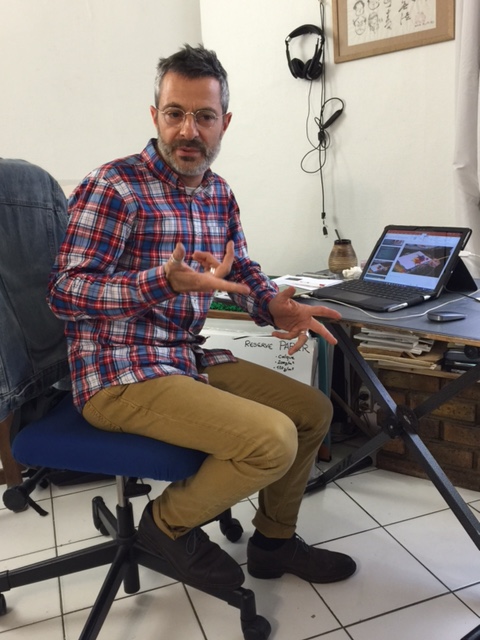 “When I share a piece of art by one of my students, I also share the story behind it,” Patrick says. “The act of creation is more important than the results.”
“When I share a piece of art by one of my students, I also share the story behind it,” Patrick says. “The act of creation is more important than the results.”
Tips:
Pick something that is easy for you, the care partner.
Put a point of color on the pages, then stand back. Offer support but don’t paint.
Enjoy the process and don’t get stuck on the results.
Thanks to Berna Huebner, founder of the Hilgos Foundation and co-producer of the documentary, “I Remember Better When I Paint,” for suggesting we meet with Patrick.
Three Top Tips for Tuning into Singing: Insights from Finland
Mom was staring into space, oblivious to my brilliant smiles and cheerful conversation. So I started to sing, just to occupy myself. I chose songs Mom liked, such as “Oh What a Beautiful Morning,” “A Summer Place,” and “You are My Sunshine.” Normally, I felt a little down when I didn’t really get to connect with Mom during my visits. But after a half-hour of being a one-woman show, I felt uplifted and energized. And Mom seemed to be making a sound much like humming.
Singing was often a part of my time with Mom. I’ve always felt happy after “making a joyful noise.” Now a study from Dr. Teppo Sarkamo and his colleagues in Helsinki, Finland, explains why.
Dr. Sarkamo’s research found that “regular musical activities can have an important role in maintaining cognitive ability, enhancing mood and quality of life” for people living with mild to moderate dementia. These activities also promote the well being of care partners and offer a beneficial leisure activity for the person living with dementia and the care partner.
Invite Out Your Inner “American Idol”
You don’t need special musical abilities to benefit from listening to music or singing. The research shows that incorporating simple musical activities in daily care is “a cost-efficient way for offering emotionally, cognitively stimulating, and enriching musical experiences.”
The study’s music therapist, Sari Laitinen, kindly offered these ideas for care partners and the person living with dementia.
- First, reserve enough time together to spend with the music. The main thing is feeling peaceful together. When singing, choose the songs together from a songbook. In our research project, we prepared a song booklet of our own for the participants, which mostly included well-known Finnish singe-a-long songs from their early years: childhood, teenage years and early adulthood. The care partner can begin by humming a melody first, and if their partner recognizes the song, they can start singing it together. Usually, the partner knows the lyrics “by heart” and their memory retrieval is quite automatic.
- Usually the songs bring about personal, autobiographical memories related to the life era and events when the songs were popular. Allow the reminiscence of your partner to proceed on its own time and terms, accepting the stories and not immediately correcting if the people or places happen to be incorrect. You want a mutual feeling of telling each other important things about life. It is all about acceptance and the understanding that something important is shared. The feeling of being understood helps to cope with life.
- Listening to music is based on the same principles as singing together: the care partner can suggest some records he/she thinks are meaningful and see what happens. When asking your partner to choose the record, it is good to have some LPs or CDs with a photo of the artist on the cover. Again, it is nice to have a quiet place for the listening and time to share the stories and the feelings that the music evokes. It is good to keep in mind that although the songs are familiar from a long time ago, the experience of music is always “here and now”. By experiencing the music together and by being sensitive to the ”reactions” (emotions, thoughts, memories) evoked by the music, the care partner can offer acceptance and validation of the experiences, the feeling of being understood. Given time, this can lead the discussion from the reminiscence of old times to themes that are important now, such as acceptance of the lived life, mourning of losses, joy in the moment, feeling of vitality, strengthening the feeling of life and so on.
For more information, visit: Singing is beneficial for memory and mood especially in early dementia
Clinical and Demographic Factors Associated with the Cognitive and Emotional Efficacy of Regular Musical Activities in Dementia, Teppo Sarkamo, Sari Laitinenb, Ava Numminenc, Merja Kurkib, Julene K. Johnson, and Pekka Rantanene a,
The Inside Story of Designing for Dementia
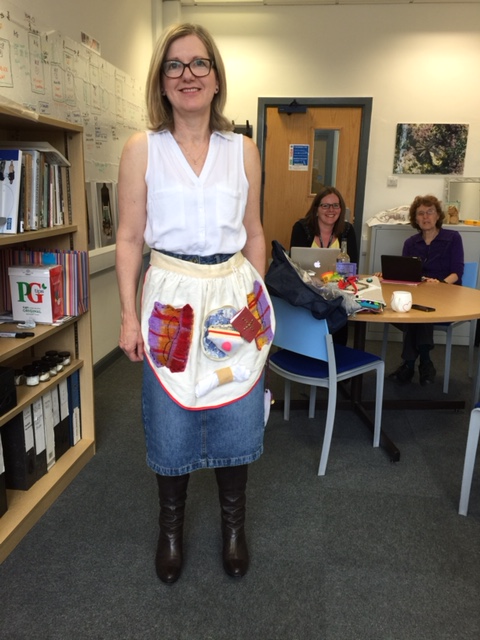 I love being around visionaries and Cathy Treadaway, PhD, is certainly one of them, changing the world one playful textile at a time. Cathy is the Professor of Creative Practice at the Cardiff School of Art and Design, Cardiff Metropolitan University, Wales, United Kingdom and she contributed to my upcoming book, Connecting in the land of Dementia: Creative Activities to Explore Together. I recently visited her at her university office in Cardiff, Wales, and wanted to share a few of her successes with you. In these stories, you’ll find intriguing ideas you can adapt to your own situation.
I love being around visionaries and Cathy Treadaway, PhD, is certainly one of them, changing the world one playful textile at a time. Cathy is the Professor of Creative Practice at the Cardiff School of Art and Design, Cardiff Metropolitan University, Wales, United Kingdom and she contributed to my upcoming book, Connecting in the land of Dementia: Creative Activities to Explore Together. I recently visited her at her university office in Cardiff, Wales, and wanted to share a few of her successes with you. In these stories, you’ll find intriguing ideas you can adapt to your own situation.
Walking in the Park Without Leaving Home
They often visited the park, walking the paths hand-in-hand, admiring the flowers and foliage, listening to the birdsong, enjoying the breeze and the fresh air. But as his dementia progressed, he could no longer navigate the park. Until Cathy Treadaway and her team created a tactile textile replica of the park, complete with interactive technology. When he pressed one of the tree icons, he heard the sound of the wind. He pressed another and was rewarded with birdsong. Now, they sit together and he traces the cloth paths and creates the sound effects as she talks about the outdoors and reminisces about their times together.
For Cathy Treadaway, that’s what her work is all about: enhancing life and keeping people connected. She specializes in creating individualized “playful objects,” interactive textiles that mirror the person’s interests and passions.
When Cathy asked about one person’s special interests, a favorite pet, a Westie, came up again and again. Cathy and her team set to work, building an apron that featured a soft white Westie that barked when pressed. The team velcroed the dog onto an apron. The woman living with dementia was fascinated by the apron and by the texture and sounds of the dog. So was her two-year-old great granddaughter. The apron gave her focus and pleasure and also offered conversation points for her multigenerational family.
Making Visits Meaningful
“Sometimes visiting someone is hard,” Cathy says. “These individualized blankets and aprons can make the experience easier and more fun for all parties.”
Cathy’s work is focused on compassionate design, using textiles as a means for retaining and building relationships. She often asks people this question: “If you could design something to strengthen the relationship between yourself and someone living with dementia, what would you design?”
For more information about Professor Treadaway and her work, please visit www.cathytreadaway.com and www.laughproject.info
Deborah Shouse is the author of Love in the Land of Dementia: Finding Hope in the Caregiver’s Journey.
COMING SOON: Connecting in the Land of Dementia: Creative Activities to Explore Together
Fulfilling the Bucket List, Trip by Trip
Our friends Elizabeth and Charlie Miller are a constant source of inspiration. Here is one of the many ways they embrace life.
Elizabeth and Charlie knew they had to instantly work on their travel bucket list. When they met and fell in love, Charlie had been living with dementia for four years. He had not traveled much, but he wanted to see the world with Elizabeth. He asked a friend to help him plan a romantic trip to San Francisco, where he proposed to her.
After she said, “Yes,” they combined their love of beaches and nature and began adventuring, going on driving trips, taking cruises, and sharing a multitude of experiences. When flying grew too complicated and stressful for Charlie, they focused on local day trips or short driving trips.
“I used to have to travel alone,” Elizabeth says. “Now, I travel with Charlie. He enjoys the trip in-the-moment. How wonderful to have all these shared experiences. Plus, it’s renewing to be outside of our routine.”
 Recently, Elizabeth and Charlie were driving around and Charlie said, “What was that long cruise last fall that had so many beautiful places?”
Recently, Elizabeth and Charlie were driving around and Charlie said, “What was that long cruise last fall that had so many beautiful places?”
Elizabeth stopped to think. “Hawaii,” she said.
“Hawaii,” Charlie said, his eyes bright. “Wasn’t that the best cruise ever?”
Elizabeth smiled and felt a deep sense of happiness and connection. “You are right. It was the best cruise ever.”
To make every trip “the best” here are a few flying travel tips from Elizabeth:
- Try for a non-stop flight at a time best for the person living with dementia.
- Call TSA in advance and arrange for assistance in getting through screening.
- Ask for a Pre-boarding pass to minimize the stress in boarding.
- Get a business-type card that says, “Thank you for your patience with my companion. He is living with dementia.” Share this information, as needed.
- Carry a travel packet that includes a letter from an MD, stating that your companion has dementia, and a medical power of attorney. Include doctors’ names and contact information as well as emergency contact information.
- Carry a bag of essentials: water, snacks, medications, a change of clothing, and activities.
- Be flexible, in the flow, and have fun!
Get Cooking on Giving Back
The assembly line stretched around the spacious dining room table and each person focused fully on his task. One man spread mayonnaise on bread. Another placed turkey slices and another added cheese. Another slipped the sandwich into a baggie and others assembled the lunches, adding potato chips and a cookie. All worked diligently; there was a special purpose to this meeting of the Men’s Club at Dolan Memory Care Homes in Creve Coeur, Missouri. They were giving these homemade meals to the fire fighters in their community as a way of showing their appreciation.
Ten residents of varying abilities, including all levels of memory impairment, contributed to the sandwich brigade. Those who needed help had an assistant with them.
“The participating residents were filled with high energy and good spirits,” says Mary Kate Halm, LMSW, Admissions Coordinator of Dolan, who organized the activity. “They were excited to be engaged.”
The local fire department had invited the group to tour the station when they delivered the lunches. The experience included opening up the sides of the fire truck. One of the residents, who was usually indifferent to outings, used to be a tool designer. When he saw the tools in the fire truck, his eyes grew wide and he became very animated.
“Everyone enjoyed being engaged in a purposeful activity. They loved the tour and they asked excellent questions,” Mary Kate says. They wanted to know the details of their training, how much each truck cost, how much their equipment weighed, and more. The residents weren’t the only ones engaged.
“The firemen loved the attention,” Mary Kate says. “Plus, they were patient, communicated clearly, and were considerate of those in walkers and wheelchairs.”
The community volunteer activity generated a lot of joy and curiosity.
“They were completely connected to the experience,” Mary Kate says. “They were learning, they were giving back, and they were fully present. We created a moment of joy and that’s all that matters.”
Get ready to give back:
Mary Kate offers these tips for connecting with the community and giving back.
- Look for a service organization that you admire. This can be emergency responders such as fire fighters, police, sheriffs, EMTs, as well as animal rescue teams, cancer support organizations, and more.
- Find a project that’s fun for you and for the person living with dementia, a project you can both participate in. If you have friends and family who’d like to help, this is a great time to get others involved.
- Coordinate with the organization and find a time to deliver your gifts. If it’s of interest, ask for a chance to learn more about the organization.
For more interesting activity ideas, visit https://t.e2ma.net/message/gxreo/4bbql
Three Marvels of Misplacing
“These days I am constantly losing things,” a friend tells me. I understand, because I frequently misplace objects and even words!
“I don’t know where my glasses are,” Mom tells me. I bite my lip; she’s been misplacing things all day. We are supposed to be spending a day drawing and painting, trying to connect mom with the artist she used to be. We are supposed to bake cookies together and look through magazines. But I’ve been spending much of the time crawling around, looking under the sofa and chairs and between the cushions for the disappearing glasses.
“Let’s make our cookies. You won’t need your glasses for that,” I say.
“I need my glasses.”
As I search, I wonder when it became a drudgery instead of a joy to find things. One of my favorite childhood games was Hide ‘N Seek. I loved being the Seeker, loved the surprise of finding someone in a tucked away, mysterious place. I had a special trick I used when I was “It.” I would close my eyes and say, “If I were Dan, where would I hide?” Then an image floated into my mind and I’d race to the hiding place. Half the time, I was right.
Do I still have “it?” I close my eyes and think, “If I were Mom’s glasses, where would I be?” The refrigerator comes to my mind. I rush into the kitchen and fling open the refrigerator door, only to see the usual chaos. But I’m hungry, so I reach for an apple. Behind the fruit is a pair of reading glasses, sprawled across the shelf.
Triumphantly, I take the glasses to Mom.
“These feel nice,” she says.
Not only has my mother reminded me of the importance of creativity, curiosity and play, but she also discovered a great summer time tip: chill your glasses and cool off your face.
Deborah Shouse is the author of Love in the Land of Dementia: Finding Hope in the Caregiver’s Journey.
COMING SOON: CONNECTING IN THE LAND OF DEMENTIA: CREATIVE ACTIVITIES TO EXPLORE TOGETHER
A Toolkit for Art Activities
“We’re going to talk about birds today and the beautiful sounds and colors they bring to our lives,” Dalia Gottlieb-Tanaka, PhD tells her client Sylvia, who was an art teacher before she was diagnosed with dementia. Dalia, the founder of the Society for the Arts in Dementia Care in British Columbia, hopes to reconnect Sylvia with her love of birds and invite out her creative abilities through discussion and painting.
“When people living with dementia have purposeful activity while interacting with others, they’re less depressed,” Dalia says. “They find more satisfaction in life. Those who’ve been indifferent and bored suddenly show desires and interests.”
Dalia conceived and developed the Creative Expression Activities Program for people living with dementia. The comprehensive program is based on the individual and includes nurturing body/soul and mind aspirations, improving the physical environment, and training family members and caregivers in their daily interactions. The program emphasizes the importance of activities that encourage creative expressions. As a result, it has the potential to reduce anxiety and stress to both client and care partner and increase the quality of life for both.
Creating a Multi-Sensory Experience
First, Dalia creates an environment rich in visual and sound affects, such as pictures of local and foreign birds, which are either from library books, magazines or calendars. She plays birdsong in the background and shows a short video on birds that was borrowed from a local library or downloaded from YouTube. Dalia orchestrates a discussion about the video, asking what Sylvia liked about it and what it made her think about. She asks open-ended questions, such as, “What do you like about birds? What are your favorites? What kind of bird would you like to be?” She spreads feathers on the table for tactile stimulation.
“Since people have different levels of cognitive and physical abilities, I try to engage as many senses as possible,” Dalia says. “That way, I increase the level of communication and involvement. For example, those who cannot hear well may still be able to smell and touch.”
After the conversation, Dalia passes out paper and invites Sylvia to paint or draw with her. They may start a picture in tandem with Dalia asking Sylvia which bird she’d like to draw.
“Doing creative activities together enriches both individuals and the relationship,” Dalia says.
Creative Sparks
• Apply Dalia’s flexible approach to arts activities to any relevant topic that might interest you and your partner.
• Adapt the ideas to meet your partner’s attention span.
• Think of a subject the two of you would enjoy exploring. Have fun collecting photos, music, video clips, and art supplies. If preparation feels too hard, ask a friend to help, or use a simplified version of this activity.
• Introduce the project, mentioning ways you both can participate. Let your partner know, “This is just for fun. There’s no right or wrong way to do this.”
• At least ten minutes before you’re ready to end, let your partner know you’re winding down.
• Work as equals, side by side, encouraging and helping as needed.
• If desired, post your artworks and share with others.
###
For more information about Dalia and her work, visit www.cecd-society.org
Consider attending the CECD 7th International Conference, September 8-10, 2016, in Vernon, BC, Canada.
Deborah Shouse is the author of Love in the Land of Dementia: Finding Hope in the Caregiver’s Journey.
COMING SOON: CONNECTING IN THE LAND OF DEMENTIA: CREATIVE ACTIVITIES TO EXPLORE TOGETHER
